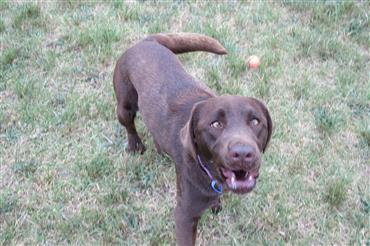
 The Labrador was originally called “St John’s Dogs,” (St John’s = capital city of Newfoundland ) and is one of the most popular breeds in most countries in the world – as a domestic or companion dog.
The Labrador was originally called “St John’s Dogs,” (St John’s = capital city of Newfoundland ) and is one of the most popular breeds in most countries in the world – as a domestic or companion dog.
The labrador retriever hails from the island of Newfoundland (eastern Canada) and used to work with fishermen helping to catch the fish that fell off lines and nets. They also used to jump in the freezing water and help pull in the nets.
By the times the 18th century rolled around they were a big export to the UK (to be used as retrievers for hunting), but this particular breed came from North of Newfoundland – a place called Labrador. In its time in Canada is is likely the dog was also bred with the Larger newfoundland dog.
From here the original retriever crossed with setters, spaniels and other retrievers making it quite a different dog to the original one that was used to a solo task.
Labrador retriever skills set
- hunting (mostly: tracking, retrieving)
- watchdog,
- police work / defence force
- Narcotics detection (customs and police work)
- Blind guide dog, disabled assistance, therapy dogs
- Search and rescue (sniffing abilities)
- sledding, carting
- Competitive obedience dog club trials, agility, etc
If you have read the previous profile of the Golden retriever you will see that they have almost the same skills set. They are quite different dogs in their work ethic and look but have been used interchangeable. The main difference seems to be the golden’s desire to have fun and goof off occasionally – hence why the lab has often been selected in deadly serious tasks like leading the blind, customs and defence force work.
Labrador Retriever Hunting dog
There are two forms of lab. Both UK and America have Show and Field versions. Naturally the hunting and working dog breeds are selected for these abilities while show breed dog lines are created for a given look and may not have much hunting instinct at all.
Physically Field Labradors are longer legged, lighter, and more thin in build with lighter coat, making them more agile and with better endurance.
For all the exceptional talents that the Labrador breed shows in the service of humans (other than hunting) it is clear that they are very intelligent and easily trainable.
But there is considerable debate among hunters as to the use of Labradors. They are an exceptional hunting dog, but many hunters have moved onto specific new breeds like the CURS that are a very regional specific breed. The lab is a bird dog and water dog foremost (as you would expect from its origins). And while the labs tend to have a thin coat, they were bred to put fat on to insulate them from the icy waters, making their metabolism relatively slow for such an energetic hunting dog.
While the hunting version of the lab is more streamlined than the show and regular domestic dog versions, you can still see obvious bulkiness of these dogs in comparison to the much faster and streamlined pointers and hounds. These dogs are built to be strong and robust more than used for long term hunts these days. They have stocky bones in their legs that assist in pulling and bringing in large game as required, but are obviously not as ‘dainty’ as many other retriever breeds, such as cocker spaniels etc.
A purpose bred thin Labrador retriever hunting dog is a formidable willing amazing thing to see.
The labrador retriever as domestic companion dog
There are very few people on earth who would not know what a Labrador looks like, showing that they are clearly a favourite dog with families. They are intelligent, trainable and can be gentle with smaller family members. The difficulty many families have is that due to their propensity to put on weight, and their original purpose of retrieving – if not exercised properly these dogs can become obese, lazy disgruntled dogs. While they make up a large percentage of any country’s pets, they also figure in a large number of dog bites and even deaths in countries such as the USA.
Any dog has its limits of abuse, and not walking a smart retriever and letting it socialise should be called as a form of dog abuse. The shame is that these breeds look so cute when they are small, and that almost everyone knows someone with one, that they often forget that they are dealing with a real live animals with real dog needs.
These dogs can become your best friend and loyal protector, but it is worthwhile heading exercise advice very seriously.